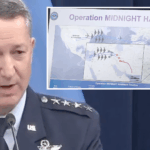
Chairman of the Joint Chiefs of Staff, Air Force General Dan Caine, provided a detailed account Sunday of Operation Midnight Hammer, the U.S. military’s precision strike on three Iranian nuclear facilities: Fordo, Natanz, and Isfahan. Caine revealed that the operation, executed by U.S. Central Command under General Eric Kurilla, involved over 125 aircraft, including seven B-2 Spirit stealth bombers launched from Whiteman Air Force Base in Missouri. The mission, which marked the largest B-2 operational strike in U.S. history, commenced at approximately 2:10 a.m. Iranian time (6:40 p.m. EST) on June 21, 2025, and concluded within 30 minutes. Caine emphasized the use of deception tactics, including decoy B-2 bombers sent westward over the Pacific to mislead Iranian defenses, ensuring the element of surprise. The operation deployed 75 precision-guided weapons, including 14 Massive Ordnance Penetrators (MOPs), also known as bunker-buster bombs, marking their first combat use.
General Caine detailed the synchronized execution of the strikes, noting that as the B-2 bombers approached Iranian airspace at around 5:00 p.m. EST, a U.S. Navy submarine launched over two dozen Tomahawk cruise missiles targeting surface infrastructure at the Isfahan nuclear site. The lead B-2 bomber then dropped two 30,000-pound GBU-57 MOPs on Fordo, a deeply buried uranium enrichment facility, followed by additional bombers striking Natanz and Isfahan. Caine reported that Iran’s air defenses, including surface-to-air missile systems, failed to detect the U.S. aircraft, and no Iranian fighter jets were scrambled during the operation. This allowed the U.S. forces to maintain complete surprise, with no shots fired at the aircraft during their ingress or egress. Initial battle damage assessments indicated “extremely severe damage and destruction” to all three sites, though Caine cautioned that a comprehensive evaluation would take time due to the lack of U.S. ground forces for direct inspection.
Caine underscored the operation’s strategic planning, which spanned months and involved minimal communication to maintain secrecy, with only a select few in Washington aware of the timing and specifics. He highlighted the mission’s complexity, involving in-flight refueling, coordination across five combatant commands, and the integration of fourth- and fifth-generation fighter jets to clear airspace and counter potential threats. The strikes were designed to “severely degrade” Iran’s nuclear infrastructure without targeting Iranian troops or civilians, aligning with President Trump’s directive to prevent Iran from acquiring nuclear weapons. Caine noted that the operation’s success was evident in the safe return of all U.S. assets and the apparent inability of Iran to mount an immediate counterattack. However, he acknowledged uncertainties regarding the full extent of damage to Iran’s nuclear capabilities, stating it was “way too early” to determine if some nuclear potential remained.
Click this link for the original source of this article.
Author: JBaron
This content is courtesy of, and owned and copyrighted by, https://www.offthepress.com and its author. This content is made available by use of the public RSS feed offered by the host site and is used for educational purposes only. If you are the author or represent the host site and would like this content removed now and in the future, please contact USSANews.com using the email address in the Contact page found in the website menu.







